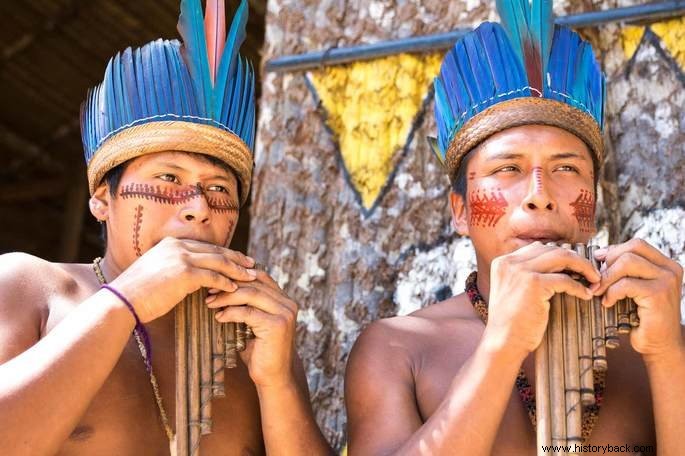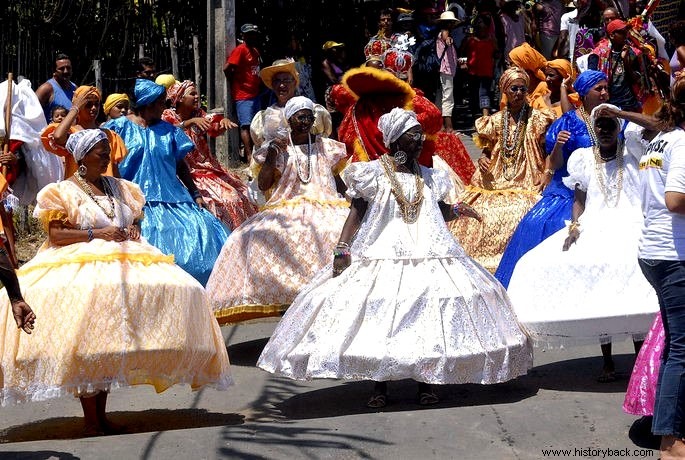The Brazilian people are the result of the miscegenation of several peoples.
The indigenous, Portuguese and Africans are the main groups.
However, there are several European and Asian immigrants who came to Brazil, especially from the 19th century onwards, who also formed the Brazilian people.
Indigenous people and the formation of Brazil
The territory that would become Brazil has recorded the presence of humans for 12,000 years.
The indigenous people occupied every surface, especially the coast. We should not think that they were a single people, but several indigenous tribes, each with its own language and customs.
The most numerous ethnic group were the Tupi-Guarani, and it was with them that the Portuguese made contact.
The Tupi knew nature, they had named the mountains, beaches and rivers, they knew which herbs were harmful or not. All this was taught to the Portuguese.
One of the clearest examples of the permanence of indigenous culture in Brazil can be seen through proper names, such as Itapoã , Piratininga , Para , etc.
In cooking, the intensive use of manioc stands out, a plant that had been domesticated by the indigenous people and which is a mandatory item in several Brazilian dishes.
See also:Tupi-Guarani Culture See also:Indigenous Culture
See also:Indigenous Culture Europeans and the origin of the Brazilian people
Portuguese
The first European group to arrive in Brazil were the Portuguese. These carried out the sea voyages with several goals:they wanted precious metals, land, expand Christianity and glory in battles. There were plenty of reasons to cross the “Ocean Sea”.
The Portuguese introduced new concepts of society, economy and religion, very different from indigenous customs. One of the examples is the economy:instead of planting for subsistence, it was now necessary to grow products on a large scale that could be sold on the European market.
They also brought their religion and imposed it on the indigenous people. Through belief came the festivities, the language (Latin and Portuguese) and a new philosophy of life. Instead of multiple gods, now only one deity was worshiped, there was a book to follow and a hierarchy of priests.
In addition to religion, Portuguese became the language of the new territory, as well as political organization and the capitalist economy.
See also:Brazil ColonyDutch
Likewise, during the colonial period, we have to consider the influence of the Dutch, especially in Pernambuco.
The arrival of the Dutch meant the arrival of a new religion, Calvinism. In the beginning, this generated several conflicts of a religious nature with episodes of destruction of Catholic temples.
The Dutch, also called Batavians, remained twenty-four years before being expelled by a Portuguese-Spanish fleet.
See also:Dutch InvasionsAfricans in the formation of Brazil
Africans were brought to be slaves in the Americas.
However, each individual brought their language, their faith and their skills. In this way, this knowledge was disseminated both on the farms where they worked and in the quilombos, which were spaces of freedom.
Despite all the brutality of slavery in Brazil, Africans introduced foods such as beans and okra. In music, his influence would give the cadence and syncopated rhythm typical of Brazilian popular music.
Likewise, in dance, we found that the way of moving the waist was inherited from Africans, which gave rise to an infinity of dances such as maxixe and samba.
Africans, like the Yoruba and Jeje peoples, brought the religion and its orixás, which were mixed with Christian belief. This gave rise to Candomblé terreiros and, later, to Umbanda in Brazil.
In addition, several African words were incorporated into Brazilian Portuguese, such as quilombo, marimbondo, moleque, farofa, cochichar, quitute , etc.
 See also:African Culture
See also:African Culture European immigrants in Brazil in the 19th century XIX and XX
During the 19th century, after the arrival of the Portuguese court, Brazilian ports were opened for trade with other nations. Likewise, people of any nationality who wanted to make a better life were able to settle in Brazil.
In this way, waves of Italians, Germans, Swiss, Poles, Spaniards and Arabs from different origins came to Brazil.
Each of these waves of immigrants added their culture and customs to Brazil. Thus, we have a series of dishes, such as kibbeh and esfirra, of Arab origin; as well as the introduction of pasta and meatballs by the Italians, for example.
On the other hand, at the beginning of the 20th century, Japanese immigration was stimulated by the governments of both countries. As a result, Brazil has the largest population of Japanese descendants in the world.
See also:Immigration in BrazilMestizaje in Brazil
The union between the different human biotypes ended up generating individuals who were not completely indigenous, white or black, in terms of the genetic aspect.
This phenomenon is called miscegenation or miscegenation and is very present in Brazilian society.
As this was a society that was guided mainly by skin color, the new tones gained specific names.
Let's take a look at some of them:
| Name | Origin |
|---|---|
| Mameluco, caboclo, caiçara | Mestizo of white and Indian (the coppery skin color resembled the Egyptian Mamluks) |
| Curiboca | son of an Indian with a mameluco |
| Mulatto | son of black and white |
| Brown | child of mulatto with white |
| Cafuzo | son of a black man with an Indian |
| Goat | son of black with mulatto |
| Creole | son of black parents, born in Brazil |
In this way, we realize that the Brazilian people have become a great mixture, both cultural and religious, as well as genetics.
This phenomenon has been studied by several authors, including:
- Gilberto Freyre, in his work Casa-grande e senzala;
- Sérgio Buarque de Holanda, in Raízes do Brasil;
- Darcy Ribeiro, in Formation of the Brazilian People;
- Oliveira Viana, in Southern Populations of Brazil;
- Euclides da Cunha, in Os Sertões;
- Paulo Prado, in Portrait of Brazil;
- Florestan Fernandes, in Body and Soul of Brazil .
Keep researching the topic with these texts :
- Arab culture:discover its origins and traditions
- Main Features of Afro-Brazilian Culture
- Brazilian folklore:legends, games, songs, dances and parties
- Brazilian population:history and demographics
